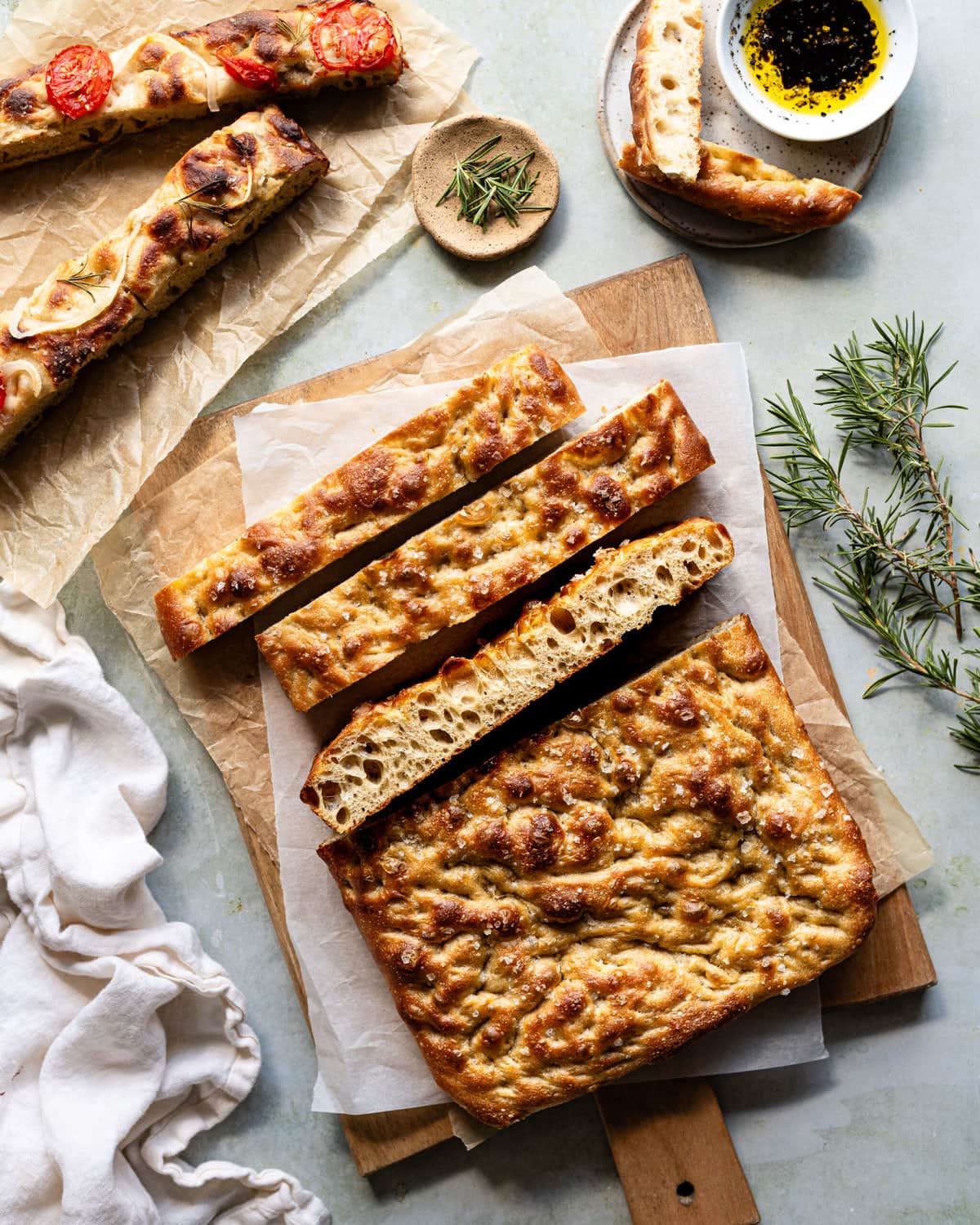Simple Sourdough Discard Focaccia Bread
Tender, spongy and full of flavor this Sourdough Discard Focaccia is easy to make and is perfect for beginners and pro sourdough bakers. Get all the sourdough flavor with the convenience of commercial yeast and bake homemade sourdough bread in just over 2 hours.
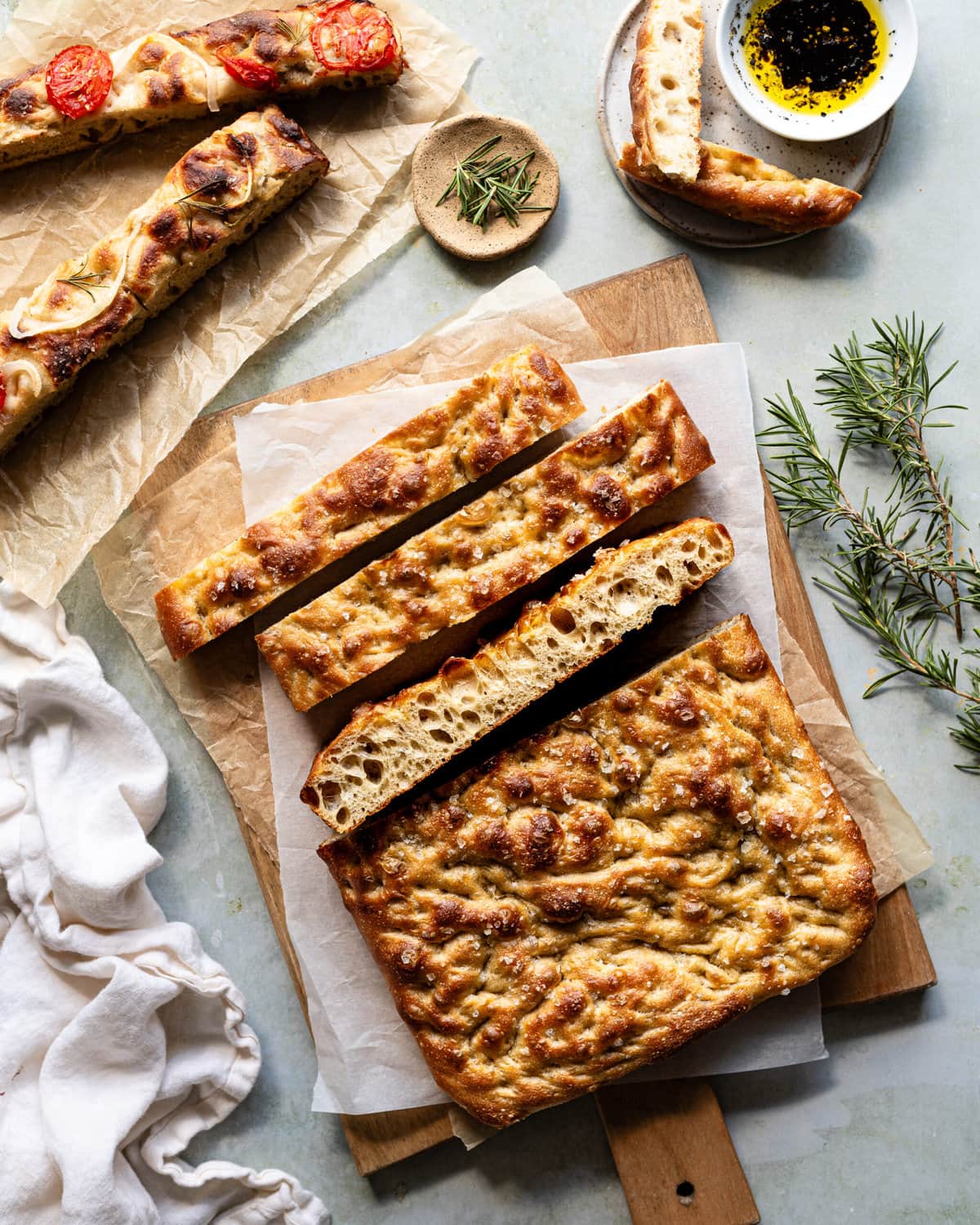
Ingredients and substitutions
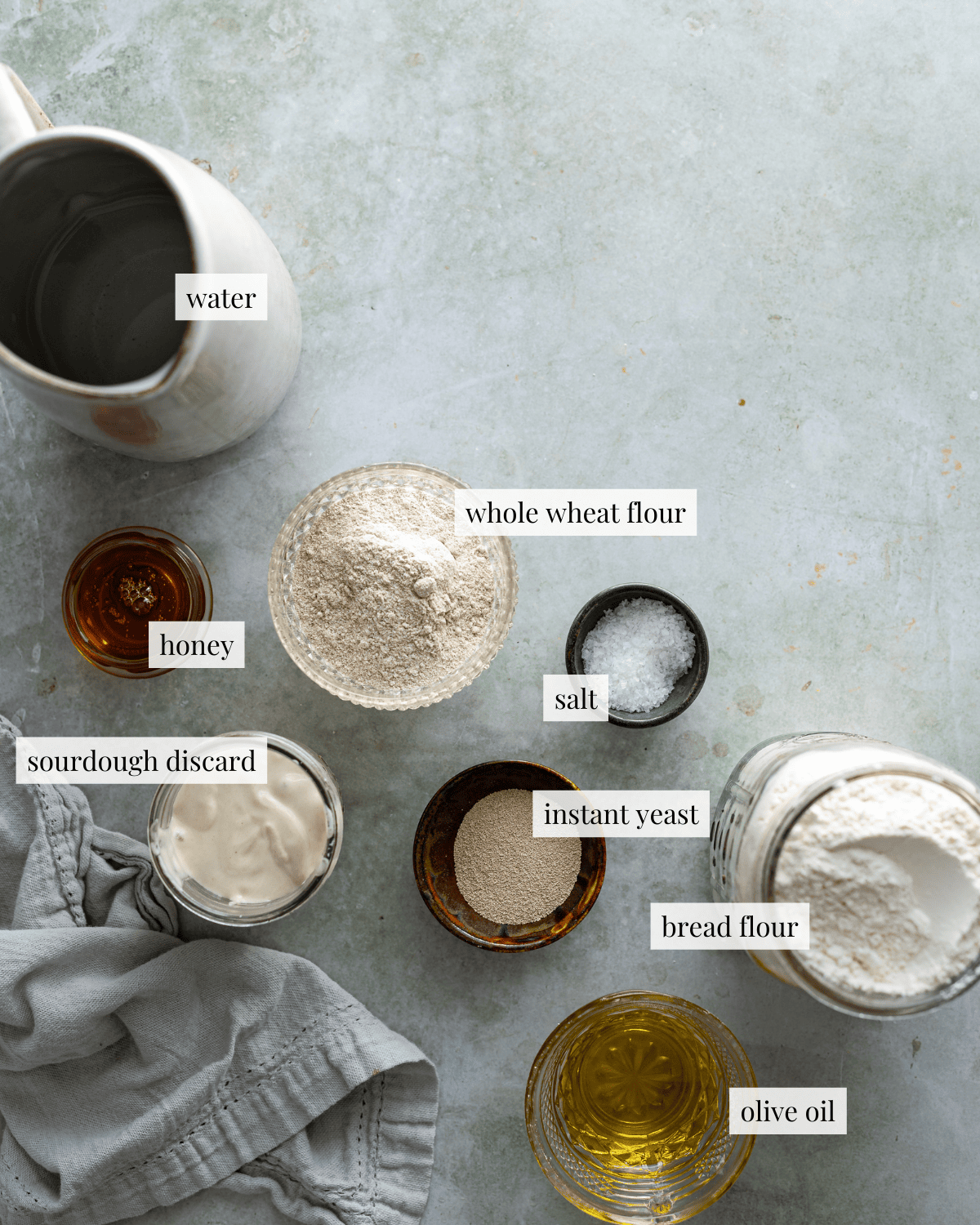
Flour choice: You can substitute all-purpose flour if you don’t have bread flour or whole wheat. Don’t attempt to use 100% whole wheat flour for this recipe or your focaccia may turn out dry and gummy.
Sourdough discard: You can use your starter directly from the fridge for this recipe. Use active sourdough starter or add 113 grams of flour and 113 grams of water to your dough if you don’t have any sourdough discard.
Olive oil: Splurge on a high-quality olive oil. Unfortunately, there is no substitute for this ingredient.
Instant yeast: You can use active-dry yeast for this recipe, you’ll just need to bloom the yeast before mixing it into your dough.
Salt: Use kosher salt or sea salt for the best results. Different types of salts have varying grain sizes so the amount of salt added to the recipe may differ if you use volume measurements.
See the recipe card for detailed ingredient information.
Tip
Commercial yeast has a shelf life. Make sure your active-dry yeast or instant yeast is still viable before attempting this recipe or your dough will not rise.
Baking with sourdough discard
This focaccia is quick to make because it uses instant yeast as the main leavener instead of an active sourdough starter. Sourdough discard adds a deep, nuanced flavor to the bread. Since it’s used solely as a flavor enhancer and not for leavening, there’s no need to activate it; you can use it directly from the refrigerator.
If you’re using sourdough starter discard that’s been in the fridge for weeks it will add more flavor, which you won’t get when using a freshly fed starter. Both will work for this recipe but you’ll get different results.

Topping variations
Focaccia is wonderfully adaptable! I like making smaller-sized focaccia so I can personalize each one with different ingredients.
Here are a few delicious combinations of my favorite toppings:
- Olive oil and sea salt (my favorite)
- Tomatoes, garlic and fresh rosemary
- Kalamata olives and green olives
- Lemon, pecorino romano, onions and pink peppercorn
Step-by-step instructions
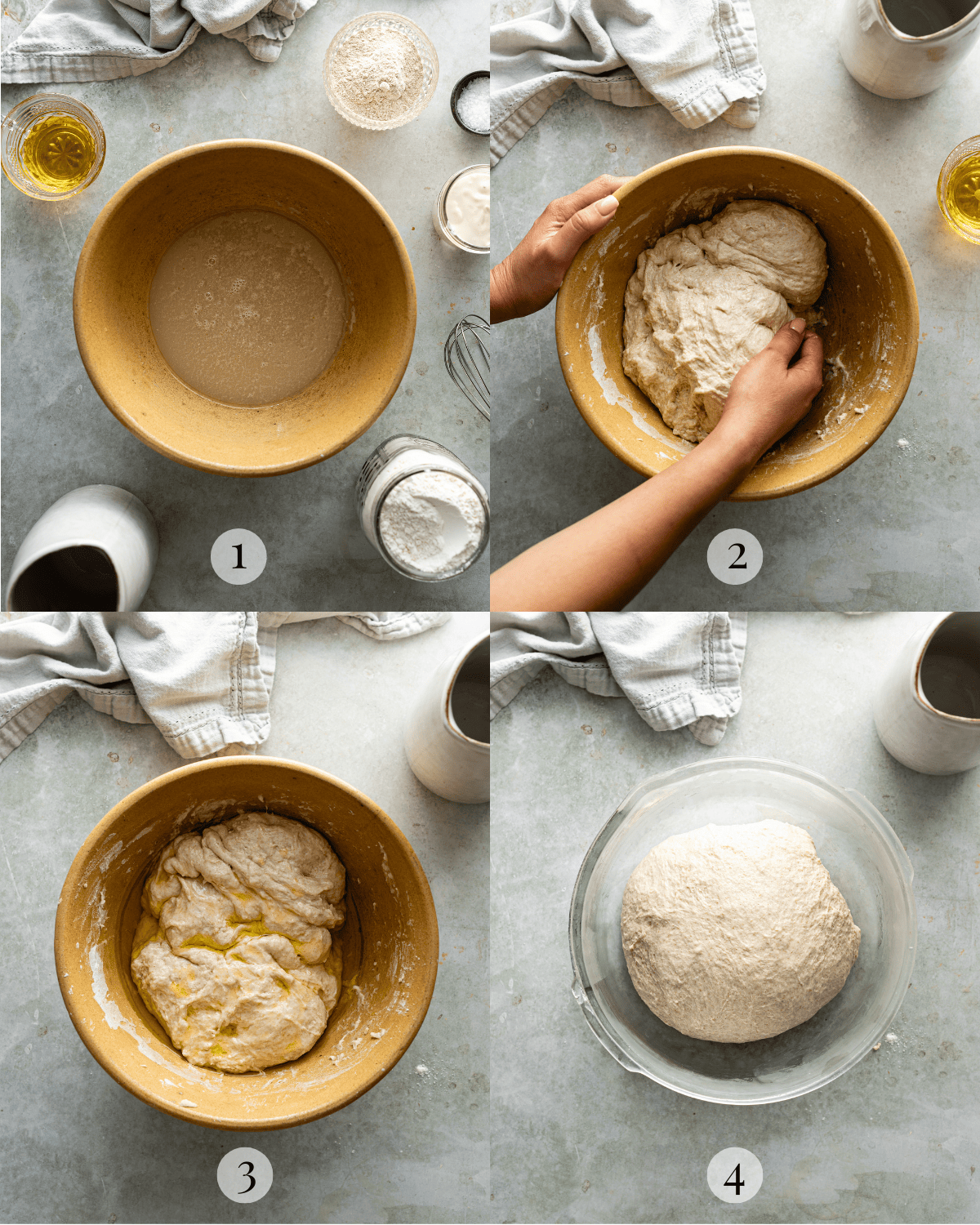
STEP 1 Make the dough: Whisk the yeast, honey and water together in a large bowl (image 1). Add the flour, salt and discard to the yeast mixture (image 2). Knead the olive oil into the dough (image 3). Transfer the dough into a clean, lightly-oiled bowl and let the dough rest (image 4).
Tip
Giving the dough some time to rest following the mixing process allows the flour to fully absorb moisture, reducing stickiness and making it more manageable.

STEP 2 Stretch and fold: Using your fingertips pick up one side of the dough and stretch it as far as you can without tearing (image 5). Fold the dough over itself, turn the bowl 90 degrees, and repeat 3 more times or until all of the sides are folded (image 6).
Tip
This dough can initially feel quite wet and sticky. Don’t try to knead it, if it feels too difficult to handle, work with wet hands and use your fingertips to pick up and fold the dough.
STEP 3 Proof the dough: Cover the bowl and let the dough proof until bubbly and doubled in volume, about 30 to 45 minutes (image 7). Divide the dough and transfer to a baking sheet coated in olive oil, gently stretching it to reach the edges of the pan. (image 8). Cover the pans until puffy and bubbly, about 30 minutes.
Tip
Be patient! Let your dough rise until it has noticeably increased in volume and looks very bubbly before baking. The bubblier your dough is, the lighter and airier your focaccia will be.

STEP 3 Bake: Dock the dough by using your fingertips to press on the surface multiple times until it reaches a consistently even thickness, then delicately stretch it towards the edges of the baking sheet (image 9). Sprinkle sea salt on top of the dough (add other toppings, if using) and bake at 425 for 25 to 30 minutes (image 10).
Bread Baking Tips
- Weigh your ingredients. Measuring with a scale is much more accurate than using cups and tablespoons, this will help guarantee your success.
- Don’t use hot water. Use cold or warm water for this recipe, water over 115 F will kill yeast.
- If the dough springs back when you try to transfer it to the pan, cover it with a greased piece of plastic wrap and let it rest for 15 minutes before proceeding. This helps the gluten to relax, making the dough more pliable and easier to stretch.
- Coat the bottom of the pan with lots of olive oil. This fries the dough as it bakes resulting in a delicious crispy crust. It also prevents your dough from sticking to the bottom of the pan as it bakes.
- Don’t use too many toppings or your focaccia may become soggy.
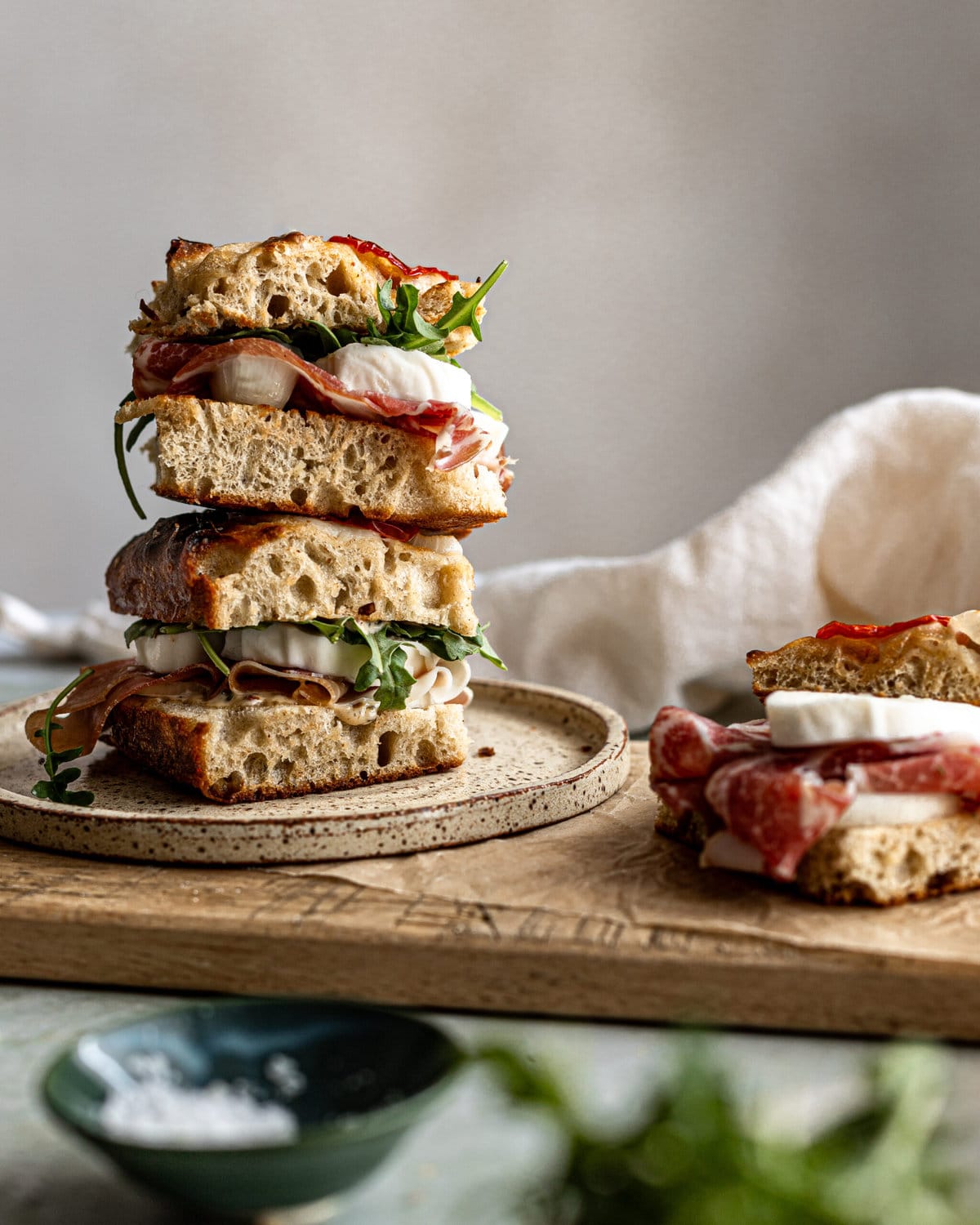
Ingredients
Dough
- 452 grams water
- 7 grams instant yeast 1 packet
- 42 grams honey or cane sugar
- 170 grams sourdough discard
- 540 grams bread flour
- 90 grams whole wheat flour
- 12 grams salt
- 56 grams olive oil
Toppings
- 56 grams olive oil
- 7 grams flaky sea salt
Suggested Toppings
- tomatoes sliced
- fresh rosemary
- onions sliced
- ground pistachios
- lemons sliced
- olives
- ground pepper
- garlic
- grapes
Instructions
-
Make the dough: Mix the water, instant yeast, honey and sourdough discard in a large bowl until no traces of discard remains.452 grams water,7 grams instant yeast,42 grams honey,170 grams sourdough discard
-
Fold in the bread flour, whole wheat flour and salt. Mix with a wooden spoon or your hands until all of the flour is hydrated.540 grams bread flour,90 grams whole wheat flour,12 grams salt
-
Knead the olive oil into the dough until it is absorbed. It will gradually feel less greasy as it absorbs the oil.56 grams olive oil
-
Cover the bowl with plastic wrap and let the dough rest in a warm place for 15 minutes.
-
Stretch and fold: After the 15 minute rest period, complete 1 set of stretch and folds.
-
To complete a stretch and fold, with the dough inside your bowl, pick up the side of the dough closest to you using your fingertips. Stretch the dough out as much as you can without it tearing and fold it over itself. Turn the bowl 90 degrees and repeat 3 more times.
-
Cover the bowl with plastic wrap. Set it in a warm place and let the dough rest for 15 minutes.
-
Complete 1 more set of stretch and folds. Cover the bowl with plastic wrap.
-
First rise: Let the dough rise at room temperature until doubled in volume. The dough should double in volume and appear bubbly, about 30 to 45 minutes.
-
Prep: Line two 9 by 13 baking sheets aluminum foil or parchment paper. Coat the bottom of the sheet pans with about 1 tablespoon of olive oil (14 grams). Preheat the oven to 425 F. (Coat bottom of the pan with 28 grams of olive oil if you’re baking 1 large focaccia)
-
Second rise: Divide the dough into two portions. Transfer each portion of dough on the prepared pans. Cover the pans with plastic wrap and let the dough rest for 15 minutes.
-
After the rest period, stretch the dough out to the edges of the pan. Cover the dough once more and let it rise for another 20 minutes or until it looks bubbly.
-
Assemble and top: Working with one portion of dough at a time, pour about 1 tablespoon (14 grams) of olive oil over the dough. Spread the oil on the dough using the palm of your hand. Using your fingertips, dimple the dough all over until it looks completely flat.7 grams flaky sea salt
-
Sprinkle sea salt and arrange toppings on the dough (if using). Repeat with the remaining portion of dough.
-
Bake: Transfer the baking sheets to the oven and bake for 25 to 30 minutes or until the focaccia looks golden brown.
-
Enjoy: Transfer the focaccias to a cooling rack. Let the bread cool for 10 minutes before slicing, more if you’re using it for a sandwich.
-
Store: This bread tastes the best the day it is baked, but will store well for up to 3 days in an airtight container at room temperature. Refrigerate leftover slices in an airtight container if you used toppings.
Tips
These recipes were developed and tested using grams for precise measurements. To increase your chances of success, I recommend investing in a kitchen scale. I’ve included rough volume estimates (in tablespoons and cups), but they might not be totally accurate.
Remember all ovens are unique, these recipes were tested in my oven which runs cooler than others. You might need to lower the temperature if your bake appears to be browning too quickly. Monitor your bake closely and make adjustments if needed.
Notes
You can substitute sugar, molasses or agave syrup for honey.
You can bake this recipe in:
- two 9 by 13 baking pans
- one 18 by 13 inch baking sheet
- three 8-inch square baking pans
- three 9-inch cake pans
- two 12-inch skillets

